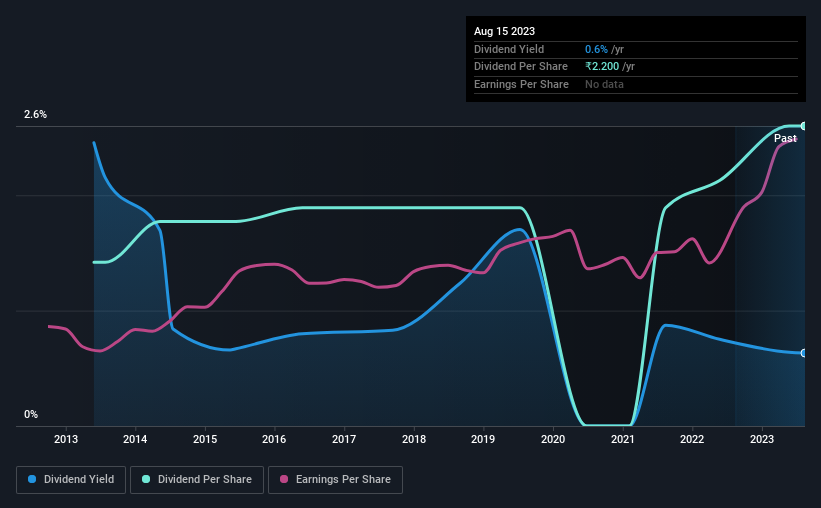- India
- /
- Electrical
- /
- NSEI:SALZERELEC
Salzer Electronics (NSE:SALZERELEC) Is Paying Out A Larger Dividend Than Last Year

The board of Salzer Electronics Limited (NSE:SALZERELEC) has announced that it will be paying its dividend of ₹2.20 on the 9th of October, an increased payment from last year's comparable dividend. This will take the dividend yield to an attractive 0.6%, providing a nice boost to shareholder returns.
See our latest analysis for Salzer Electronics
Salzer Electronics' Dividend Is Well Covered By Earnings
Impressive dividend yields are good, but this doesn't matter much if the payments can't be sustained. Salzer Electronics is quite easily earning enough to cover the dividend, however it is being let down by weak cash flows. In general, we consider cash flow to be more important than earnings, so we would be cautious about relying on the sustainability of this dividend.
If the trend of the last few years continues, EPS will grow by 12.0% over the next 12 months. Assuming the dividend continues along recent trends, we think the payout ratio could be 8.2% by next year, which is in a pretty sustainable range.

Dividend Volatility
The company has a long dividend track record, but it doesn't look great with cuts in the past. The dividend has gone from an annual total of ₹1.20 in 2013 to the most recent total annual payment of ₹2.20. This implies that the company grew its distributions at a yearly rate of about 6.2% over that duration. We have seen cuts in the past, so while the growth looks promising we would be a little bit cautious about its track record.
The Dividend Looks Likely To Grow
With a relatively unstable dividend, it's even more important to see if earnings per share is growing. It's encouraging to see that Salzer Electronics has been growing its earnings per share at 12% a year over the past five years. Salzer Electronics definitely has the potential to grow its dividend in the future with earnings on an uptrend and a low payout ratio.
Our Thoughts On Salzer Electronics' Dividend
In summary, while it's always good to see the dividend being raised, we don't think Salzer Electronics' payments are rock solid. With cash flows lacking, it is difficult to see how the company can sustain a dividend payment. This company is not in the top tier of income providing stocks.
Investors generally tend to favour companies with a consistent, stable dividend policy as opposed to those operating an irregular one. However, there are other things to consider for investors when analysing stock performance. To that end, Salzer Electronics has 4 warning signs (and 1 which can't be ignored) we think you should know about. If you are a dividend investor, you might also want to look at our curated list of high yield dividend stocks.
New: Manage All Your Stock Portfolios in One Place
We've created the ultimate portfolio companion for stock investors, and it's free.
• Connect an unlimited number of Portfolios and see your total in one currency
• Be alerted to new Warning Signs or Risks via email or mobile
• Track the Fair Value of your stocks
Have feedback on this article? Concerned about the content? Get in touch with us directly. Alternatively, email editorial-team (at) simplywallst.com.
This article by Simply Wall St is general in nature. We provide commentary based on historical data and analyst forecasts only using an unbiased methodology and our articles are not intended to be financial advice. It does not constitute a recommendation to buy or sell any stock, and does not take account of your objectives, or your financial situation. We aim to bring you long-term focused analysis driven by fundamental data. Note that our analysis may not factor in the latest price-sensitive company announcements or qualitative material. Simply Wall St has no position in any stocks mentioned.
About NSEI:SALZERELEC
Salzer Electronics
Manufactures and supplies CAM operated rotary switches, selector switches, wiring ducts, voltmeter switches, copper wires and cables, and allied products primarily in India.
Solid track record with mediocre balance sheet.
Similar Companies
Market Insights
Community Narratives




